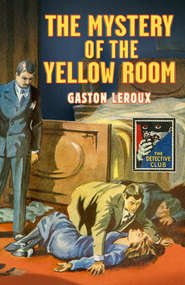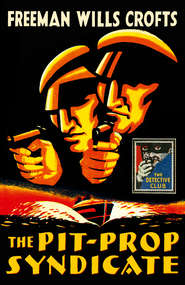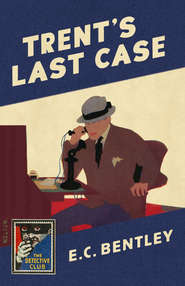По всем вопросам обращайтесь на: info@litportal.ru
(©) 2003-2025.
✖
The Leavenworth Case
Автор
Год написания книги
2019
Настройки чтения
Размер шрифта
Высота строк
Поля
Chapter XXV: Timothy Cook (#litres_trial_promo)
Chapter XXVI: Mr Gryce Explains Himself (#litres_trial_promo)
Book Three: Hannah (#litres_trial_promo)
Chapter XXVII: Amy Belden (#litres_trial_promo)
Chapter XXVIII: A Weird Experience (#litres_trial_promo)
Chapter XXIX: The Missing Witness (#litres_trial_promo)
Chapter XXX: Burned Paper (#litres_trial_promo)
Chapter XXXI: Q (#litres_trial_promo)
Chapter XXXII: Mrs Belden’s Narrative (#litres_trial_promo)
Chapter XXXIII: Unexpected Testimony (#litres_trial_promo)
Book Four: The Problem Solved (#litres_trial_promo)
Chapter XXXIV: Mr Gryce Resumes Control (#litres_trial_promo)
Chapter XXXV: Fine Work (#litres_trial_promo)
Chapter XXXVI: Gathered Threads (#litres_trial_promo)
Chapter XXXVII: Culmination (#litres_trial_promo)
Chapter XXXVIII: A Full Confession (#litres_trial_promo)
Chapter XXXIX: The Outcome of a Great Crime (#litres_trial_promo)
Footnotes (#litres_trial_promo)
The Detective Story Club (#litres_trial_promo)
About the Publisher (#litres_trial_promo)
INTRODUCTION (#u20167c21-19b4-523d-a4be-3b8628f3d827)
NOT ONLY was Anna Katharine Green (1846–1935) the first woman to write a detective novel—thereby earning the soubriquet ‘The Mother of Detective Fiction’—but she also included in it many themes and ideas that later became commonplace in the genre.
(#litres_trial_promo) And as further proof of her importance in the development of detective fiction she also introduced, later in her career, two distinct ‘types’ of detective, each very different, each contributing to an emerging form; and each much copied in the years that followed.
Born into a well-to-do family in New York’s Brooklyn Heights, Anna Catherine
(#litres_trial_promo) Green was raised, on the death of her mother, by a stepmother who encouraged Anna’s interest in writing. After graduating with a B.A. from Ripley College in Vermont in 1866—an impressive achievement for a woman at that time—she submitted some poems to the eminent American poet Ralph Waldo Emerson. He encouraged her to continue writing, but advised her to abandon poetry. Green, fearing that her lawyer father would not approve of novel-writing, began, in secret, to write a detective novel. When, on its completion, she did show it to him, he was sufficiently impressed—possibly because of the novel’s significant legal content—to arrange for a well-known critic to bring it to the attention of publisher George Putnam. The Leavenworth Case: A Lawyer’s Story was published in the US in 1878 and in the UK the following year. It was an immediate success and marked the beginning of a prolific writing career.
Appearing almost half a century before the heyday of the Golden Age, The Leavenworth Case embodies many of that era’s distinctive features. Ebenezer Gryce, described by himself as ‘a professional detective’, and one who would feature in a dozen novels over the following thirty years, investigates the murder, in his New York home, of wealthy Horatio Leavenworth. The reader is presented with the body in the locked library, a victim on the point of changing his will, a floor-plan of the murder scene, a coroner’s inquest with medical and ballistic evidence, and a second death. We encounter a lawyer-narrator, Everett Raymond, with a romantic interest in the outcome of the case, a butler, a secret marriage, an initialled handkerchief, a second floor-plan, and that device beloved of many later Golden Age writers: a numbered listing of significant points. All of these are instantly recognisable from hundreds of detective novels over the following century.
Ebenezer Gryce is described as ‘a portly, comfortable personage with an eye that never pounced’. Unlike the gimlet eye of many detectives, his rarely rested on the person he addressed but ‘was always on some insignificant object in [the] vicinity’, variously described as being ‘on intimate terms with the door-knob’ or as ‘fixing his eyes upon the poker though not with any hostile intention’. Distinct from many investigators, Gryce does not dominate or draw attention to himself and this unpretentiousness makes him a character with which readers can identify. He is self-made, self-effacing, unencumbered by family and uncomfortable in the presence of members of the upper-class; and he is a rheumatism sufferer. All of which goes some way to explain why he is rarely listed among the Great Detectives.
Viewed from today’s perspective the novel can be considered somewhat over-written and, in certain passages, sentimental. The narrator rhapsodises a shade too much over the beauty of the two main suspects; said suspects are given to fainting conveniently, and vital evidence is delayed in the interests of gallantry. But none of this should deter the reader who relishes a well-constructed plot with an unequivocal emphasis on ‘Whodunit’. And throughout the novel facts are fairly offered to the reader—the Book I inquest is a model of legal and forensic presentation—with inferences drawn from these facts. Particularly impressive also are the discussions of, and deductions drawn from, letters in Books II and IV.
The significance of Green and The Leavenworth Case can be judged by the interest shown by two eminent contemporary practitioners of the form: Arthur Conan Doyle, with whom Green had corresponded, made a point of meeting her when he visited America in 1894; and writing in The Critic on 28 January 1893, Wilkie Collins, author of the ground-breaking The Moonstone (1868), admired both the plot and the manner of its telling:
‘[Green’s] powers of invention are so remarkable—she has so much imagination and so much belief (a most important qualification for our art) in what she says … Dozens of times in reading the story I have stopped to admire the fertility of invention, the delicate treatment of incident—and the fine perception of event on the personages of the story.’
If the creator of Sherlock Holmes and the pioneer of the detective novel are not two impressive enough advocates for Green’s reputation, then the discovery that Agatha Christie was an admirer surely is. Before embarking on her first book, The Mysterious Affair at Styles, she had read little detective fiction but records in An Autobiography (1977) how much she had enjoyed the Sherlock Holmes stories—then still appearing intermittently in the StrandMagazine—as well as two influential novels: The Mystery of the Yellow Room (1908) by Gaston Leroux (1868–1927) and The Leavenworth Case. Although she mis-spells the title of Green’s novel, its influence on Christie’s early work is evident in the adoption, and adaptation, of many of its elements; elements which would become synonymous with the detective novel during the imminent Golden Age of Detective Fiction.
If we amend ‘locked library in New York’ to ‘locked bedroom in Essex’ the influence of Green’s novel on The Mysterious Affair at Styles is clear: an upper-class domestic setting, a lovelorn male narrator who also acts as the detective’s helper, a wealthy victim, a contentious will, a limited circle of suspects, the inclusion of a floor-plan and the plot device of an incriminating document; furthermore, the method adopted by the killer to conceal that document is identical in Leavenworth and Styles. More than forty years later, during his investigation of The Clocks (1963), Hercule Poirot, musing over milestone titles of detective fiction, comments on The Leavenworth Case’s ‘studied and deliberate melodrama’, noting particularly ‘the excellent psychological study’ of the murderer and calling the book ‘admirable’ overall. And if that’s the opinion of Hercule Poirot, who are we to disagree?
Anna Katharine Green continued to write for the next forty years, producing over thirty novels and five short story collections. In 1897, at which stage she had published fourteen novels and one collection, she introduced the spinster detective Amelia Butterworth, narrator of That Affair Next Door. When a young woman with a face battered beyond recognition is found in the neighbouring house, Amelia joins forces (unofficially) with Leavenworth’s Gryce to solve the mystery. Their collaboration is initially antagonistic and it is not until they compare notes that they successfully solve the case. Amelia Butterworth, the earliest example of the elderly female detective, the meddlesome amateur with time on her hands and curiosity on her mind, appeared in two further novels.
Almost twenty years later, in The Golden Slipper (1915) Green introduced, in a series of linked short stories, yet another detective: the young, professional female. Violet Strange is not merely a younger version of Amelia Butterworth; she is a detective through necessity. Although from a privileged background Violet needs money (for a purpose not disclosed until her last adventure, ‘Violet’s Own’) and undertakes professional detection for a fee. Although many of her cases are concerned with theft or missing valuables some (e.g. ‘The Second Bullet’) involve the investigation of a mysterious death. Like most of Green’s output the setting is among the privileged classes, a milieu through which Violet can move with ease and conviction.
In 1884 Green married Charles Rohlfs, an actor—he collaborated with her in the stage dramatisation of The Leavenworth Case in 1891—and, later, a highly respected furniture designer. The couple had three children, two of whom tragically pre-deceased them. Green published her final novel, The Step on the Stair, in 1923. She died in New York on 11 April 1935; Charles died in June 1936.
The Leavenworth Case was filmed as a silent movie directed by Charles Giblyn in 1923, and was remade as a more lavish ‘talkie’ by Lewis D. Collins, released in 1936. A different ending to the American release had to be filmed to satisfy the British film censors, leaving UK viewers somewhat bemused at the illogical change of identity of the killer at the end of the film. Both versions of the 1936 black-and-white film survive, although the only known US print is sadly incomplete, having been heavily re-edited for television in the 1950s.
The contribution of Anna Katharine Green to the development of detective fiction is immense, and The Leavenworth Case was an obvious choice for inclusion in the first batch of Detective Story Club classics in 1929. The book showed, as Wilkie Collins noted, impressive ‘fertility of invention’ in a well-constructed and well-paced story, full of much that subsequently became commonplace in the genre. Her creation of two types of female detective paved the way for countless followers. Green, a pioneer in a genre that would later come to be dominated by women, was, indeed, ‘The Mother of Detective Fiction’.
DR JOHN CURRAN
December 2015
BOOK ONE (#u20167c21-19b4-523d-a4be-3b8628f3d827)
CHAPTER I (#u20167c21-19b4-523d-a4be-3b8628f3d827)
‘A GREAT CASE’ (#u20167c21-19b4-523d-a4be-3b8628f3d827)
‘A deed of dreadful note.’
—MACBETH
I HAD been a junior partner in the firm of Veeley, Carr & Raymond, attorneys and counsellors at law, for about a year, when one morning, in the temporary absence of both Mr Veeley and Mr Carr, there came into our office a young man whose whole appearance was so indicative of haste and agitation that I involuntarily rose at his approach and impetuously inquired:
‘What is the matter? You have no bad news to tell, I hope.’
‘I have come to see Mr Veeley; is he in?’
‘No,’ I replied; ‘he was unexpectedly called away this morning to Washington; cannot be home before tomorrow; but if you will make your business known to me—’
‘To you, sir?’ he repeated, turning a very cold but steady eye on mine; then, seeming to be satisfied with his scrutiny, continued, ‘There is no reason why I shouldn’t; my business is no secret. I came to inform him that Mr Leavenworth is dead.’
‘Mr Leavenworth!’ I exclaimed, falling back a step. Mr Leavenworth was an old client of our firm, to say nothing of his being the particular friend of Mr Veeley.










